Riede Castle
The Riede Castle is a Renaissance building in Riede , a district of Bad Emstal in the northern Hessian district of Kassel . It stands on the site of a former castle on the western outskirts of Riede below the Klauskopf .
history
The first written mention of the village of Riede comes from the year 1074. The castle was probably built on the foundation walls of a courtyard of the Augustinian monastery in Merxhausen . This original structure seems to be evidenced by a Romanesque chapel until the 19th century (when the south wing was added in 1886 the chapel was demolished).
In 1443 the first verifiable owner, Henne von Wehren , who held it as a fiefdom of the Landgraves of Hesse , sold the property to the Hessian noble family von Meysenbug . In 1563, using extensive parts of the existing building, the palace was built in the Weser Renaissance style, with a knight's hall in the center. The Renaissance cast iron panels in the bay room date from 1574, based on the designs of the Hessian iron caster Philipp Soldan .
In 1674, Wolrad von Meysenbug added a manor to the castle , a simple hall with a half-timbered tower . Also in the 17th century, a herb garden that still exists today was laid out. On behalf of Leo von Meysenbug , the attic was rebuilt in 1695 and received baroque design elements. During further renovations in the 18th century, the closedness of the facility was lost. Around 1770, Heinrich von Meysenbug added an early romantic English landscape garden to the palace complex . His master horticulturalist Johann Heinrich Müntz was buried in the garden of Riede Palace in 1798.
In 1810 the Meysenbug family died out with Heinrich von Meysenbug, and the fiefdom fell back to the then sovereign, Jérôme Bonaparte , King of the Napoleonic Kingdom of Westphalia , who named it seven weeks later to his master stable master, Count von Ried (e) General Philippe François Maurice d'Albignac gave. However, he never saw Riede personally and did not enjoy the property for long, because he soon fell out of favor with Jérôme, returned to France and died in Paris in 1824.
After the restitution of the Electorate of Hesse-Kassel in 1813, Elector Wilhelm I withdrew the rule of Riede as a settled fiefdom and offered it to Lieutenant General Wilhelm Engelhard, the son of the Hessian historiographer Regnerus Engelhard , with the simultaneous award of the expired Meysenbug noble title. Engelhard refused, however. In 1815 Wilhelm I transferred the castle to his son, Elector Wilhelm II , whom he banished there for four weeks in 1819 with his mistress Emilie Ortlöpp . The electoral prince Riede bitterly offered it to Lombard assessor Reusch for 40,000 thalers, which he had carefully looked after and maintained until then, but he refused. The castle, park, farm buildings and estate were then given to Chamberlain Rudolph von Buttlar zu Elberberg (1802–1875) for 34,000 thalers , who in 1825 turned them into a family entrepot. He owned the property until it was sold in 2007. In 1886, today's south wing was added as a half-timbered construction .
The now seriously neglected castle and manor was sold to new private owners in 2007 and completely renovated from 2008 to 2014. This company, also with public funds and supported by the Association for the Promotion of Riede Castle, was awarded the German Prize for Monument Protection in 2012. Today, the castle contains three separate apartments on three floors, with only part of the total of 62 rooms in the building being used for this. The large castle park with its historic cascade system has also been renatured and restored, and the last thing to be renovated is the farm buildings of the adjoining former estate.
The castle is not open to the public.
Building description
The outer
The castle is a rectangular building with a narrow, tower-like western extension, a corner risalit on the northeast corner and a round stair tower on the east side. The three-story solid building with a stone base is plastered except for the western extension. The southern extension is a plastered half-timbered extension from 1878.
The main entrance is to the right of the stair tower. The segment arch portal with separate skylight and double coat of arms in a rectangular frame is framed by fluted pilasters . The double coat of arms shows the coat of arms of Leo von Meysenbug († 1593) and that of Gladebeck . The lintel is marked in 1563. The stair tower with basement is four storeys high; the top floor is at roof level and has rectangular windows. On the lower floors, the windows are set at an angle and turn to the left in accordance with the flight of stairs of the spiral staircase . The windows have rabbets and throats , just like the individual or coupled windows of the rest of the building, which are irregularly arranged. The corner projectile consists of broken cuboids, under the windows there is a surrounding cornice .
The baroque mansard roof is expanded with gables .
The castle has a large farm yard with barns and a massive administration building. One building is designed as a church.
At the inside
The basement in the southern room has a round pillar . The ground floor is divided into three parts: a middle hall with a Gothic door to the room to the right and a renaissance door to the room to the left and the stair tower. The right hall on the north side has a Gothic beamed ceiling on a girder as well as a bay room with oak paneling that was later partitioned off . On the entrance wall above the door there are weapon emblems and Gothic tracery . A closet with an old iron lock is built into the north wall , probably from the 16th century. The west extension built by Wolrad von Meysenbug (1632–1702) contains a small baroque room with a corner fireplace . In the place of the former chapel there is now a kitchen. The tripartite division of the floor plan continues on the upper floor.
Castle Park
Heinrich von Meysenbug , the owner of the castle at the time, began to create a park in the new style of the English landscape park around 1770 . This was done based on the example of the Kassel Bergpark Wilhelmshöhe , where these new ideas were taken up at the time. Landgrave architects and garden designers from Kassel such as Heinrich Christoph Jussow , Karl Steinhofer and Daniel August Schwartzkopf were also active in planning and consulting in Riede. Johann Heinrich Müntz , who came to Kassel in 1786 after spending several years in England, had a major influence on the design of the new landscape park in Riede .
The landscape park was created on the eastern slope of the Klauskopf (the Bergpark Wilhelmshöhe on the eastern slope of the Habichtswald) and stretches (as in Kassel) to the east down to the castle. Due to the connections and similarities to Kassel, the castle park in Riede is also known as the "Kleine Wilhelmshöhe". The development of the park ended with Meysenbug's death in 1810.
The landscape park in the early romantic sentimental style was planted with numerous native and exotic trees and bushes and built with monuments and park architectures that were connected by paths and axes. The design and planting allowed views of the surrounding landscape. It is typical of the early romantic style that monuments and park architectures were occupied with the themes of friendship, love, death and mourning.
In 1976, Lucius Burckhardt undertook his original walk in the former landscape park with students from what was then Kassel University , thereby establishing the promenadology .
In 2001, the first garden conservation measures began in the park. The "Heinrich von Meysenbug-Path" was designed to commemorate its spiritual creator. The Meysenbugsche Landschaftspark is no longer preserved as a complete work, but a number of interesting fragments remind of its existence.
Today's picture
The historic landscape park in Riede can now be roughly divided into 3 areas:
- The castle park, or castle garden, as the horticultural core area of the park, which connects directly to the north of the castle building. There is still a remarkable population of trees there today. After restoration work, the water features were put back into operation in 2010 and the original basalt stone compound of the "Devil's Bridge" was restored.
- The open land area west of the castle, with the zoo , in front of the forest edge.
The garden-architectural element of the Patte d'oie (crow's foot) can be found there. What is meant is a Y-like course of the route, with a central visual axis, roughly in an east-west direction, and two kinking "toes". The northern one is an avenue of pyramidal oaks , the southern one of linden trees .
In the zoo between 2008 and 2010, 150 apple, pear and plum trees of old varieties from northern Hesse and the neighboring Westphalia were planted to fill the gaps in the stand.
- Forest and forest edge (forest park) on the Klauskopf with the remains of staffage buildings and park architecture of the landscape park. This forest park was separated from the entire property of the castle area in 2005.
The castle and castle park with zoo are privately owned and not easily accessible. The remains of the landscape park in the forest and on the edge of the forest are accessible via paths, since 2016 via the two adjacent circular routes 1 and 2 marked with a yellow number. Circular route 1 runs south of the Klauskopf, over the Ried'sche Tränke . The northern circular route 2 runs around the Klauskopf and along the edge of the Tiergarten , with a view of Riede Castle and the western edge of the impressive trees near the castle.
Buildings and park architectures

|
The obelisk , erected in 1775, in memory of her sister Caroline Philippine, who died in 1774. The building, in the forest southwest of the Klauskopf , stands at the western end of the (former) line of sight to the castle park. Their east end is marked today by the “everything and nothing” memorial stone.
|
OSM link for map display: Obelisk | |

|
The memorial stone with the inscription EVERYTHING AND NOTHING is in the park, about 50 meters northwest of the castle building. Today it marks the east end of the (former) line of sight. At its western end, in the forest, is the obelisk.
Originally, the monument had been in the forest since 1791, on the summit of the Klauskopf , it was not until 1856 that it had to give way to the construction of an observation tower. Since then, the stone has been in the castle park. |
OSM link for map display: Everything and nothing | |

|
The memorial stone is in the park, about 100 meters north of the castle building.
The stone commemorates the visit of the family of Landgrave Wilhelm IX. in July 1789 in Riede. The memorial originally stood at the edge of the forest and was only moved to the palace park during World War II. |
OSM link to the map display: memorial stone | - |
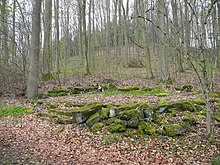
|
From the Temple of Friendship on the edge of the forest north of the castle, built in 1790, only remains of the foundations remain.
The building had an elliptical basic shape with a closed back and a front divided by 4 columns. The wooden structure was surrounded by a ring of basalt blocks and collapsed in 1927. The temple was dedicated to Diana , the Roman goddess of the hunt, and dedicated to Count zu Waldeck. |
OSM link to the map display: Temple of Friendship | |
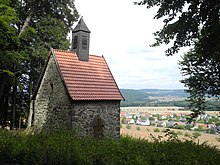
|
The chapel on the edge of the forest south of the castle, built in 1799 according to plans by Heinrich Christoph Jussow .
The neo-Gothic building and its furnishings were based on Hirschfeld and his theory of garden art , which had appeared a few years earlier. The building, also known as the temple , may have served Meysenbug and his circle of friends for the purposes of meditation and philosophizing, but it is not certain whether meetings of the Rosicrucians also took place there. |
OSM link to map display: chapel | |

|
The Hermitage , built at the end of the 18th century, of the building only remains of the foundations. The location on the edge of the forest is about 50 meters northwest of the chapel .
The square foundation made of roughly hewn tuff has a side length of 3.60 m. It was uncovered in 2003, and the remains of a pebble pavement were found. |
OSM -Link to the map display: Hermitage | |
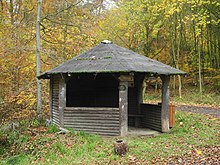
|
The straw temple is at a crossroads in the forest, at the junction to the Klauskopf and about 150 meters northeast of the obelisk . The building is no longer in its original state.
Originally, the temple was actually thatched and stood slightly above the surrounding paths. The forest roads in the forest have now been widened and piled up and today's wooden refuge stands in a slight depression. The stone benches from the interior can be found in the palace park today. |
OSM link to map display: Straw temple | |

|
The Müntz monument , erected in 1799, in memory of Johann Heinrich Müntz who died in 1798 . The building is located in the forest southwest of the Klauskopf , it was made by the Kassel sculptor Johann Christian Ruhl . | OSM link to the map display: Müntz monument |
Trees in the castle park
In the remaining core area of the park, which connects directly to the north of the castle building, there is still a remarkable population of trees. There are also other old trees in the area.
| photo | Common name | Botanical name | particularities | location | more pictures |
|---|---|---|---|---|---|
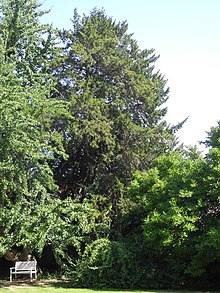
|
European yew | Taxus baccata | European yew tree on the eastern edge of the park area, today designated as a natural monument . In 1939 the German Dendrological Society (DDG) went on an excursion to the palace gardens. The report says: “In Riede [...] there were rustic trees. The yew tree on the farm building had a straight shaft 2 ½ m high with a circumference of 285 cm and a magnificent screen 10 m high, [...] ”. The age of the tree was estimated at "900 years". Today, the yew tree in the Riede Castle Park is one of the trees for which the age was not only estimated, but scientifically determined (see List of Natural Monuments in the Kassel District # Age-Determined Trees ). An examination in 2005 found it to be around 350 years old. Today this tree is the oldest in the Riede Castle Park and one of the mightiest and therefore oldest examples of yew trees in Germany. Trunk circumference: 3.80 m Year of planting: approx. 1655 |
OSM link to the map display: Natural monument yew | |

|
Pyramidal oak | Quercus robur 'Fastigiata' | Pyramid oak on the eastern edge of the park area. The tree shows the age form of the pyramid or columnar oak, in which the branches do not grow so steeply upwards and the growth of the tree is therefore more broad. This tree with a trunk circumference of almost 5 meters is one of the mightiest pyramid oaks in Germany. Trunk circumference: 4.95 m Planting year: approx. 1800 - 1850 |
OSM link to the map display: pyramid oak | - |
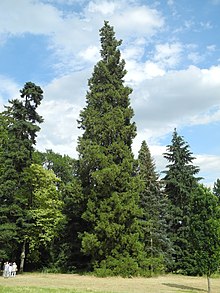
|
Giant sequoia | Sequoiadendron giganteum | Giant sequoia in the west of the park area, at the Tiergarten . The huge tree is branched to the ground. It is one of the oldest examples of its kind in Germany. Trunk circumference: 6.85 m Planting year: around 1856 |
OSM link to the map display: Giant sequoia | - |

|
Spanish fir | Abies pinsapo | Spanish fir in the west of the park area, at the zoo . This conifer is possibly the oldest specimen of its kind in Germany. Trunk circumference: 2.80 m Year of planting: around 1856 |
OSM link to the map display: Spanish fir | |

|
English oak 'Fürst Schwarzenberg' | Quercus robur 'Prince Schwarzenberg' | Pedunculate oak of the shape 'Fürst Schwarzenberg' in the northwest of the park area. The shape has a variegation on the second leaf shoot, the so-called Johannist shoot . This tree is probably the most powerful and therefore probably the oldest specimen of this form in Germany. Trunk circumference: 2.75 m. Planting year: late 19th century |
OSM -Link to the map display: Pedunculate oak 'Fürst Schwarzenberg' | |

|
Sycamore maple 'Leopoldii' | Acer pseudoplatanus 'Leopoldii' | Sycamore maple of the shape 'Leopoldii' in the northeast of the park area. The shape has a variegation . Trunk circumference: 2.65 m |
OSM -Link to the map display: Sycamore maple 'Leopoldii' | - |

|
Copper beech | Fagus sylvatica f. purpurea | Copper beech in the middle of the park. Trunk circumference: 4.50 m |
OSM link to the map display: copper beech | - |

|
Pyramidal oaks | Quercus robur 'Fastigiata' |
Avenue of old pyramid oaks in the north of the Tiergarten . The avenue consists of about a dozen trees and runs between the horticultural core zone of the park and the edge of the forest in the northwest. It forms another axis, north of the visual axis between the obelisk and the all and nothing memorial stone. |
OSM link to the map display: Allee der Pyramideneichen | |

|
Head linden | Tilia |
Alley of linden trees south of the zoo . The avenue consists of a few older trees and a few replanting and runs between the outskirts of Riede and the edge of the forest in the southwest. Its course follows a historic avenue of lime trees in the landscape park and continues today in a forest aisle and a forest path. The Kopflindenallee forms another axis, south of the visual axis between the obelisk and the all and nothing memorial stone. |
OSM link to the map display: Allee der Kopflinden | |

|
Summer linden trees | Tilia platyphyllos |
3 summer linden trees immediately south of the castle park are now designated as natural monuments . The 3 linden trees flank the path to the Klauskopf and the Riede hiking car park . Two trees stand north and one tree south of the path. The two eastern of the 3 linden trees have lost their crown in the past and are only about half the height of the western tree. Trunk circumference: up to 4.30 m Planting year: approx. 1885 |
OSM links to the map display: northwest linden tree northeast linden tree southeast linden tree |
|

|
Blood beeches | Fagus sylvatica f. purpurea |
2 copper beeches on the edge of the forest west of the Tiergarten . The two trees are roughly flanking an axis from the castle building to the summit of the Klauskopf . Northern copper beech trunk circumference: 3.00 m Southern copper beech trunk circumference: 3.70 m |
OSM links to the map display: northern copper beech on the edge of the forest southern copper beech on the edge of the forest |
- |
literature
- Association for the Promotion of the Castle in Riede eV (Ed.): "Die Kleine Wilhelmshöhe" Castle & Park Riede , Bad Emstal - Riede, 2011
- Association for the Promotion of the Castle in Riede eV (Ed.): The Vorwerk des Schloss zu Riede , Bad Emstal - Riede, 2014
- Association for the Promotion of the Castle in Riede eV (Ed.): Landscape Gardens - Garden Landscapes Castle and Village Riede , Bad Emstal - Riede, 2017
- Anonymous: Tiedemann's monument not far from Riede in Niederhessen . In: Newspaper for the Elegant World , March 10, 1807.
- Eduard Brauns: Travel guide through North Hesse and Waldeck . A. Bernecker Verlag, Melsungen, 1971, p. 97.
- Georg Dehio: Handbook of the German art monuments. Hessen I , 1st edition Deutscher Kunstverlag 2008, ISBN 978-3-422-03092-3 , p. 717.
- Major General a. D. Eisentraut: Lecture on February 19, 1917 on "The Lords of Meysenbug". In: Messages to the members of the Association for Hessian History and Regional Studies. Born 1916/17, Kassel, 1917, p. 36.
- Rolf Müller (Ed.): Palaces, castles, old walls. Published by the Hessendienst der Staatskanzlei, Wiesbaden 1990, ISBN 3-89214-017-0 , pp. 102-104.
- Bruno Jacob: Something else from the Parke zu Riede . In: Kasseler Post , March 29, 1925
- Rudolf Knappe: Medieval castles in Hessen. 800 castles, castle ruins and fortifications. 3. Edition. Wartberg-Verlag, Gudensberg-Gleichen 2000, ISBN 3-86134-228-6 , p. 33.
- Holger Schulz: The early romantic, sentimental forest park of Riede . In: Die Gartenkunst 10 (2/1998), pp. 243-259.
Web links
- Riede Castle, Kassel district. Historical local lexicon for Hesse (as of February 7, 2014). In: Landesgeschichtliches Informationssystem Hessen (LAGIS). Hessian State Office for Historical Cultural Studies (HLGL), accessed on September 12, 2014 .
- The Riede Schloss in the wiki of the project "Renaissance Palaces in Hesse" at the Germanic National Museum
- Front of Riede Castle, 2011
- Draft for a park building by Heinrich Christoph Jussow, elevation, 1798 , from: Architectural drawings in the graphic collection of the Staatliche Museen Kassel. Explanatory text see under "Print preview".
- Draft for a neo-Gothic, ruinous park building, perspective view, attributed to Heinrich Christoph Jussow, around 1800 , from: Architectural drawings of the graphic collection of the Staatliche Museen Kassel. Explanatory text see under "Print preview".
- Architekturmuseum.ub.tu-berlin.de - plans of Ludwig Dihm's palace in 1880
References and footnotes
- ^ Hugo Brunner: History of the royal seat of Cassel. Verlag Pillardy and Augustin, Cassel 1913 p. 298
- ^ German National Committee for Monument Protection: 2012 Silver Hemisphere
- ↑ Schloss Riede shines again in new splendor; HNA, September 4, 2014
- ↑ Renovation completed: Riede Castle is beaming again, Burgerbe.de, September 5, 2014
- ↑ Paragraph according to Maren Brechmacher-You: Gardens, parks and buildings of the castle estate Riede , in: Association for the promotion of the castle in Riede eV (Ed.): Landscape gardens - garden landscapes castle and village Riede , Bad Emstal - Riede, 2017, p. 10 -15
- ↑ cf. Maren Brechmacher-you: Gardens, parks and buildings of the castle estate Riede , in: Association for the promotion of the castle in Riede eV (Ed.): Landscape gardens - garden landscapes castle and village Riede , Bad Emstal - Riede, 2017, p. 14
- ↑ cf. Dr. Johannes Kahl and Jan Bode: Historical fruit varieties in the Ried "Tiergarten" , in: Association for the promotion of the castle in Riede eV (Ed.): Landscape gardens - garden landscapes castle and village Riede , Bad Emstal - Riede, 2017, pp. 62–68
- ^ Sentence on forest ownership according to Norbert Zimmermann: Artists & Philosophers in Riede , in Association for the Promotion of the Castle in Riede eV (Ed.): "Die Kleine Wilhelmshöhe" Castle & Park Riede , Bad Emstal - Riede, 2011, p. 56
- ^ Sentence with height after Norbert Zimmermann: Künstler & Philosophen in Riede , in Association for the Promotion of the Castle in Riede eV (Ed.): "Die Kleine Wilhelmshöhe" Castle & Park Riede , Bad Emstal - Riede, 2011, pp. 31-34
- ^ Paragraph on the story according to Norbert Zimmermann: Artists & Philosophers in Riede , in Association for the Promotion of the Castle in Riede eV (Ed.): "Die Kleine Wilhelmshöhe" Castle & Park Riede , Bad Emstal - Riede, 2011, pp. 20-21
- ^ Paragraph on the story according to Norbert Zimmermann: Artists & Philosophers in Riede , in Association for the Promotion of the Castle in Riede eV (Ed.): "Die Kleine Wilhelmshöhe" Castle & Park Riede , Bad Emstal - Riede, 2011, pp. 24-25
- ^ Paragraph on construction and building history according to Norbert Zimmermann: Artists & Philosophers in Riede , in Association for the Promotion of the Castle in Riede eV (Ed.): "Die Kleine Wilhelmshöhe" Castle & Park Riede , Bad Emstal - Riede, 2011, p. 26 -27
- ↑ cf. the drafts in the mhk's online catalog 3.101.1.1 - vineyard, estate of the district administrator of Meysenbug, design for a park building, elevation and 3.101.1.2 - vineyard, estate of the district administrator of Meysenbug, design for a park building, elevation
- ^ Paragraph on the story according to Norbert Zimmermann: Artists & Philosophers in Riede , in Association for the Promotion of the Castle in Riede eV (Ed.): "Die Kleine Wilhelmshöhe" Castle & Park Riede , Bad Emstal - Riede, 2011, pp. 43–45
- ^ Paragraph after Norbert Zimmermann: Artists & Philosophers in Riede , in Association for the Promotion of the Castle in Riede eV (Ed.): "Die Kleine Wilhelmshöhe" Castle & Park Riede , Bad Emstal - Riede, 2011, pp. 49-50
- ^ Paragraph on the building history according to Norbert Zimmermann: Artists & Philosophers in Riede , in the Association for the Promotion of the Castle in Riede eV (Ed.): "Die Kleine Wilhelmshöhe" Castle & Park Riede , Bad Emstal - Riede, 2011, pp. 51–53
- ↑ Paragraph on building history according to Norbert Zimmermann: Artists & Philosophers in Riede , in Association for the Promotion of the Castle in Riede eV (Ed.): "Die Kleine Wilhelmshöhe" Castle & Park Riede , Bad Emstal - Riede, 2011, p. 27
- ↑ Paragraph and quote from Volker André Bouffier: The remarkable tree population in the castle park Riede , in: Association for the promotion of the castle in Riede eV (publisher): Landscape gardens - garden landscapes castle and village Riede , Bad Emstal - Riede, 2017, p. 26– 39
- ↑ cf. Bouffier p. 30
- ↑ Measurement 2019-07-06 in h = 1.30 m
- ↑ Bouffier p. 37
- ↑ Measurement 2019-07-06 in h = 1.30 m
- ↑ Bouffier, p. 37
- ↑ Theorem after Bouffier, p. 31
- ↑ Measurement 2019-07-06 in h = 1.30 m
- ↑ Bouffier, p. 39
- ↑ Theorem after Bouffier, p. 31
- ↑ Measurement 2019-07-06 in h = 1.30 m
- ↑ Bouffier, p. 39
- ^ Sentence after Bouffier, p. 34
- ↑ Measurement 2019-08-31 in h = 1.30 m
- ↑ Bouffier, p. 39
- ↑ Measurement 2019-08-31 in h = 1.30 m
- ↑ Measurement 2019-08-31 in h = 1.30 m
- ↑ cf. List of natural monuments in Bad Emstal
- ↑ Measurement 2019-09-21 in h = 1.30 m
- ↑ Measurement 2019-09-06 in h = 1.30 m
Coordinates: 51 ° 12 ′ 29.5 ″ N , 9 ° 15 ′ 9 ″ E













